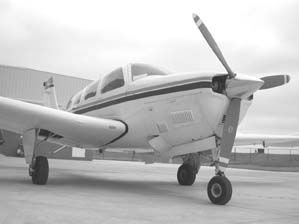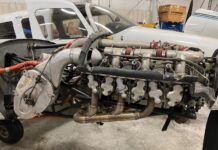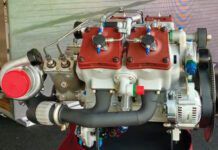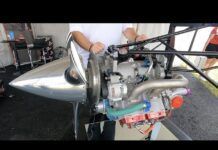The formula for going fast in an airplane is neither cheap, economical nor easy to achieve but the concept is simple: chip away at drag, pump out all the horsepower you can find and pay for and fly it as high as possible. No surprise then that the majority of fast GA piston airplanes are turbocharged and show their best speeds in the teens and low 20s.
But like the sound barrier, 200-knot cruise speeds have proven elusive for piston singles and even some twins. A few turbocharged singles-the Cessna 210, the Bonanza A36TC/B36TC, the Mooney 252-inch up on the magic 200 knots but fall frustratingly short. If they just had a little more power-5 or 10 percent, say-the equation would change.
And that appears to be the operative theory behind newly improved turbonormalizers from Tornado Alley Turbos, the Ada, Oklahoma-based sister company of General Aviation Modifications, Inc. TATs new systems do indeed allow Bonanzas-including the 36 series-to sneak right up on 200 knots and a bit beyond. With range-enhancing tip tanks, 200-knot-plus cruise speeds are transformational, increasing the normally aspirated A36s best cruise numbers by some 40 knots.
If that sounds like smoke and mirrors, it isn’t. But it does reflect some new thinking in GA engine management bordering on what some may consider the heretical. TAT says its engines can be routinely operated flat out, at 85 to 90 percent power, outputs that are entirely off the charts in the stock POHs. Is this lunacy or can this idea be sustained? To arrive at the answer, a little history.
Turbonormalizing Defined
TAT was formed in 1999, following the purchase of what was then the FlightCraft line of turbonormalizers. Owners like these expensive mods but some complained that for all the speed enhancement at high altitude, the FlightCraft systems tended to sap low-altitude performance to less than that of an equivalent normally aspirated engine.
Since acquiring the STCs, TAT has significantly reworked the systems, with improved mechanical hardware, more efficient intercooling and the addition of better cylinder baffling. The improved performance from the upgrades is substantial, especially at lower altitudes.
Were not quite sure where the term turbonormalizing originated, although its easy enough to give a working definition. A turbo system thats capable of holding the manifold pressure at 30 inches but no more is considered to be a turbonormalizer because it maintains sea-level normal as altitude increases. Turbo systems that boost above 30 inches-and many factory installations do- are called ground boost systems because they boost manifold pressure above the sea-level value. There’s really nothing magic about turbonormalizing versus ground boosting. Ground boosting is just normalizing with an extra kick of manifold pressure. In theory, that ought to produce more power and speed. In practice, it has often produced excess heat, induction inefficiencies and maintenance headaches.
TAT has attacked this shortcoming on several fronts, beginning with high compression pistons. Traditionally, engine makers have bought detonation margins in turbocharged engines by using low compression pistons, typically 7.5-to-1 versus the 8.5-to-1 pistons used in non-turbocharged engines. This is a little like taking one step backward to go two forward, since what you gain in detonation margin you lose in horsepower production and efficiency. Theoretically, the turbo boost makes up for the power losses of lower compression but that doesnt always mean the airplane goes much faster.
Because they start out as normally aspirated engines, TATs turbonormalized powerplants have 8.5-to-1 pistons and since they never get above sea-level boost-at least not by much-and have efficient intercooling, the detonation risk is minimal. But the magic to these systems-and its more basic physics than magic-is improved thermal efficiency. Although its counterintuitive, higher compression pistons are more thermally efficient, as explained in the graphic on page 11. The higher compression piston squeezes the fuel/air charge harder so its gas expansion ratio upon burning is higher than at a lower compression value.
For the equivalent manifold pressure and fuel/air charge density, the higher compression piston delivers more power and the downstream EGTs are significantly lower because of more efficient burning. This translates to a cooler, more efficient engine that delivers more horsepower on the same fuel or less fuel on the same horsepower. The fact that TATs engines are intended to be operated lean of peak means that they burn less gas and run cooler. (We confirmed this by flying two TAT-equipped Bonanzas.)
Speaking of cooling, intercoolers are another important element of the TAT systems. The factories havent been keen on intercooling; some have used it, some havent. The Bonanza B36TC, for example, doesnt have intercooling and its performance suffers for it. Intercooling addresses another one-step-back-two-forward shortcoming of turbocharging.
When air is compressed, it gets hotter and also less dense. Less dense air means the fuel/air charge contains less energy. Ideally, to get the most power, you want pressurized air thats also cool and thats what intercoolers do; they cool the air before it enters the cylinders. (On our test flight, we noted a 75-degree temperature drop in the TAT intercooler system.)
Efficient intercooling is tricky stuff and, again, not many manufacturers have gotten it just right and neither did the original FlightCraft turbonormalizer. TAT found that the original intercooler was too small and the ram air plumbing leading into and through the intercooler had efficiency-robbing twists and turns. This also created some exhaust gas pressure issues that stunted the engines volumetric efficiency. TATs George Braly told us this alone was probably responsible for the mediocre low-altitude performance of the FlightCraft systems. Correcting these flow issues dramatically increased the engines potential power output.
New and Improved
In touring TATs shop, we clapped eyes and hands on the new and improved components, which, together, the company calls the Whirlwind II system. Its original version of the FlightCraft system was called the Whirlwind. What does it all add up to? First, the airplanes. The TAT STCs apply to all four-place Bonanzas from the S35 forward, the G33 model and to all of the 36 models. (The B36TC has to be re-engined, however.) FlightCraft had developed normalizers for the Cessna 177RG and Cessna 185 and these are also offered.
Prices are not for the squeamish; we said the formula for speed was simple, not cheap. For Bonanza mods-using either the IO-520 or IO-550, the complete price is $42,950. This assumes that your airplane has either of those engines in relatively healthy shape and that the aircraft itself is sound and suitable for the modification which is, make no mistake, major surgery for the airplane. Youll need a digital multi-probe engine analyzer, which is a condition of the conversion.
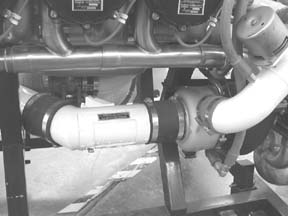
The Bonanza model range has a confusing and jumbled history made recently more difficult to grasp thanks to the availability of IO-550 conversions. Consider the G33 model Bonanza, for instance. It came from the factory with a 260-HP IO-470 but could also have been converted to either an IO-520 or, more recently, an IO-550 of up to 300 HP. TATs Whirlwind applies to either the 520 or 550 series, but not the airplanes original IO-470. V35 model Bonanzas have the 285-HP IO-520 but many have been upgraded to the 300-HP IO-550.
Last, the 36 series Bonanza. Older models have the IO-520, newer ones the IO-550. Again, some older models have been upgraded to the IO-550. TATs Tim Roehl told us that an IO-550 is worth about 150 to 200 FPM in additional climb, 5 to 7 knots in cruise speed and a gallon an hour more of fuel flow over an IO-520.
When a new engine is needed, TAT recommends what it calls a GAMISPEC engine overhaul, either a 520 or 550 series.
This includes a number of performance/durability improvements including balanced rotating parts, ported, flowed and matched Superior Millennium cylinders, forged pistons and piston-ring gaps set to minimum dimensions, among other items on a long list.
Typically, if an owner opts for the GAMISPEC and TAT together, the total invoice will come to between $70,000 and $75,000. For the Cessna 185, the TAT system sells for $34,950 and for the Cessna 177RG Cardinal Cruiser package, the price is $32,950. Although the Bonanza conversions are obviously the fastest (and most expensive), all of the TAT systems offer similar hardware and the price includes installation. (This can be done at Ada or an approved shop.)
The system includes a Garrett turbocharger with wastegate and automatic controller and all the plumbing, turboGAMIjector balanced fuel nozzles, a high-efficiency intercooler, new induction piping and a new, heavy-wall stainless steel exhaust system using 0.065-inch material. Buyers also get improved baffling, which GAMI calls the LiquidAir system.
During our tour of TATs Ada shop in February, we examined the production facility and were shown various improvements made to the FlightCraft system. The photo on page 9 shows whats arguably the most important one: an improved, more efficient intercooler with less restrictive plumbing. We were impressed with the re-engineering of the induction piping, including a clever magnetic door for alternate air with a microswitch indicator, alerting the pilot that alt air is active due to an iced primary inlet.
Weight, Performance
All of this swell hardware adds to the aircraft weight, of course, a total of 79 pounds, plus 25 pounds if you opt for an onboard oxygen system. Thirty-five series Bos have an aft-tending CG problem, so the TAT system helps address that by moving the CG 1 1/2 inches forward. In the 36 series, the CG change is essentially neutral. As for payload, this conversion offers something unusual: it actually improves it on most models. On the B36TC, for instance, the Whirlwind II includes a 192-pound gross weight increase, still in the utility category. TAT expects to receive approval for gross-weight increases on other models-ranging between 342 and 489 pounds.
The A36 series will soon have gross weight increase of 400 to 450 pounds. (Contact TAT for specific model information.) Even with the addition of tip tanks-Osborne or DShannon-the TAT 33 and 36 series Bonanzas will carry more people and stuff than stock models and with up to 120 gallons of fuel, they offer more loading and range flexibility.
And, of course, speed. As we reported in the August, 2003 issue, factory turbocharged models are faster than their non-turbocharged equivalents but we also noted that the speed enhancement is often disappointing, given the expense of getting it and the need to drag the airplane into the teens or flight levels. Based on several test flights, we think the bang-to-buck ratio of the TAT conversion is more favorable than that of a many factory systems because the TAT airplanes are fast and economical.
The fuel/range economic Delta is substantial, by the way, and its what makes the TAT systems potentially transformational for owners who make long trips.
Here are some specifics: We flew a 1980 TAT-converted A36 Bonanza. The airframe had some Smith speed mods so it wasnt typical, however. On takeoff from Ada on a 38-degree day, we easily achieved 1400 FPM in initial climb rate, settling to about 1200 FPM above 5000 feet.
Leveling off at 14,000 feet, we recorded 207 knots TAS at 17 to 18 GPH, with cylinder head temps in the 250 to 280-degree range. As per George Bralys recommendation, the engine was operated with wide open throttle, and lean of peak by leaning to a target fuel flow, not an EGT/TIT value. Climbing higher, we saw 214 knots TAS at 17,500, on about 18 GPH.
This is what Braly calls go-fast mode. The go-far mode involves simply reducing the RPM to about 2200, which knocks the fuel flow back to 15.8 GPH for a true airspeed of about 200 knots. In that scenario, with long-range tanks, the max range of the airplane, assuming a 45-minute reserve, increases to nearly 1500 nautical miles from the 1200 to 1300 miles in go-fast mode.
A direct comparison with a like model is possible. From the Beechcraft A36TC POH, we note that at max cruise power at 17,500 feet, the airplane is supposed to cruise at 190 knots on 17.5 GPH. In economy mode, it does about 154 knots on 11.5 GPH. Neither the Beech POH nor TATs supplemental data give percentage power for these values, just MP and RPM settings.
Operationally, that omission isn’t important but examining power is instructive for direct comparison. At max cruise, the stock A36TC POH shows 31 inches of MAP and 2400 RPM for its 190 knot speed. The TAT system required a bit less MAP than that to deliver 214 knots on roughly the same fuel. There are prop and drag differences between these two airframes-we mentioned the speed mods-but not enough to account for 24 knots of speed differential.
Whats going on? The TAT system is making more power-about 85 to 90 percent-which the factory systems cant match without running hot, if they can match it at all. A TAT A36-no speed mods-should be capable of 205 to 210 knots.
One obvious concern is engine durability at those power outputs and we wont be surprised if traditionalists launch a whisper campaign suggesting that these engines will never bear the strain. Its a fair question. isn’t flogging along at 85 percent power hard on an engine? Perhaps. Well know more as these new systems are fielded in larger numbers.
But TATs documentation points to the preferred operating mode, which is lean of peak, using target fuel flows and CHT limits no higher than 380 degrees. On our test flight, our observed CHTs were no higher than 280 degrees. If heat is an engine killer-and everyone one seems to agree that it is-the TAT systems don’t seem to suffer the problem. Whether continuous high power ops-up to 90 percent–will exact wear and tear in other ways will be revealed with ongoing field experience.
But test cell data and flight experience suggests this wont be the case. TATs Braly told us that mean cylinder pressures in the TN engines are higher at these power levels than in a normally aspirated engine but peak pressures are substantially lower than they are in ground-boosted systems. With less heat load, long-term durability of TAT engines may prove a test case for efficiency and durability.
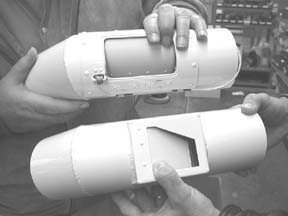
Conclusion
Given the cost of this modification, its obviously not for everyone. Unless you need an airplane that goes fast over great distances, its not cost effective for 100-mile joy rides, in our view. On the other hand, if you need a serious traveling machine, the right way to look at the TAT Whirlwind II is to ask what else will go 210 knots on 17 to 18 GPH, single or twin. Or what will go 200 knots on just under 16 gallons? Other than TAT-equipped four-place Bonanzas, our list includes only one airplane: the Continental-powered Malibu, one of the most efficient stock aircraft the industry has ever produced. Rocket Engineerings Mooney conversions are as fast or faster than the TAT Bonanzas but not nearly as economical nor do they have the range. The same applies to the Mooney Bravo and the Cessna turbocharged 210s.
The Malibu will just touch these kinds of speeds and economy but at a far higher purchase price and without the long range and payload flexibility. In spring of 2004, the original 1984 Malibu retails for about $285,000. You could buy a mid-time 1984 A36 and install the TAT system for $25,000 less. Or buy a 1975 model for $145,000, put in the TAT mod, paint and upholster it and install a state-of-the-art panel and be $30,000 ahead.
The Malibu has pressurization, of course, while the A36 doesnt. But the Piper also has higher maintenance costs so on a per-mile or per-hour basis, its more expensive to operate than a TAT A36. (The Lycoming-powered Mirage isn’t in the same league as the TAT A36, economy wise.)
Worth mentioning is that an airplane with an expensive conversion will usually return only a fraction of its installation cost at resale and we see no reason that these economics don’t apply to the TAT package.
Actually, we see one reason: under an arrangement with Beechcraft, many new A36s are being flown to Ada for the TAT mod. Given that $42,950 is a fraction of the $700,000 cost of a new A36, we cant see an argument against putting a Whirlwind II conversion on a new A36.
As for older airplanes, spending this much makes sense if you have the need for speed and plan to keep your airplane for some time to come. Whether on a new or older aircraft, we havent see a turbo installation thats better engineered or that delivers as much economical performance for the money. Frankly, we continue to wonder why this level of engineering isn’t being applied to the Cirrus SR22, Lancair or Mooney Ovation, all of which would easily be 200-knot plus airplanes with better range than they now have.
Contact – Tornado Alley Turbos, 888-359-4264, www.taturbo.com

